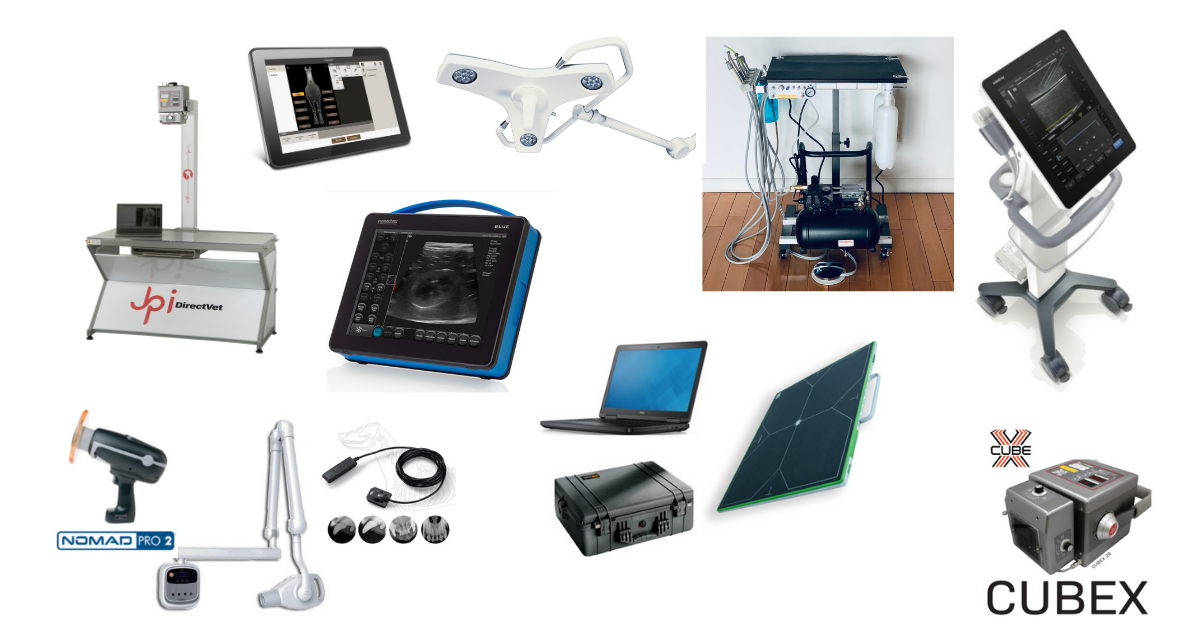Equipment Options for Your New Veterinary Practice: New-Used
If you’re ready to take the leap and open the veterinary practice of your dreams—or if you’re still exploring options and seeing if practice ownership is right for you—finding the veterinary equipment you need is an important part of the process.
After all, it’s difficult to diagnose and treat patients without the proper tools.
Depending on the type of practice you open, your equipment wish list may include…
X-ray and ultrasound machines.
In-house bloodwork analyzers.
Surgical lights, an autoclave, and anesthesia monitoring equipment.
IV pumps.
Exam room tables.
Kennels.
A scale to weigh patients.
A tonometer for measuring intra-ocular pressures.
A dental cleaning unit.
Computers, and veterinary clinic software.
Credit card processors for payments.
A washer and dryer.
Separate refrigerators for medications and for your staff to keep their lunches in, and a freezer for cadavers.
Specialty equipment, such as a vehicle for a mobile practice, and pneumatic drills, and an MRI for a neurology practice.
Plus, there are smaller items to consider, like otoscopes, blood pressure cuffs, staff uniforms, and all your daily supplies like needles, syringes, and gloves.
With all this in mind, it’s not surprising that your equipment costs could add up to tens of thousands of dollars—or more—making your equipment a vital consideration when opening and financing a veterinary practice.
Not to worry, though, because you do have options.
Considerations for Purchasing Veterinary Equipment
Purchasing new equipment is certainly an option many practice owners pursue. It’s exciting to get the latest technology delivered to your practice’s door, and—depending on the type of equipment—installed by experts. And, the equipment should be in excellent condition because it’s brand new.
When buying new, it’s important to do your research, though. Be sure you’re getting good quality and the best value for your dollar.
Also, check the manufacturer’s or seller’s warranty—because there would be nothing worse than investing your money only to have a malfunction (less likely with new equipment, but possible) or have something get dropped or broken during the grind of daily practice.
And finally, ask about support and training. For example, who do you call when you have a question about the machine? And, does the company offer training to your staff, to ensure the equipment is used to its maximum potential?
Purchasing used veterinary equipment can also be an excellent option. Many machines are designed to last for years, and your colleagues may want to sell relatively new equipment in order to upgrade. This can be a great benefit to you because you can catch a real bargain.
For used equipment, we recommend usedvetequipment.com, a site exclusive to veterinary professionals looking to buy or sell veterinary equipment, with guidance on shipping and a moderator for payments. But, you may find quality used equipment through other online sellers or medical equipment specialist resellers, too.
With used equipment, inquire about the condition. Also, ask if there is a warranty still in place—you don’t want to miss out if it is still in place and transferrable.
Finally, consider maintenance costs with any equipment you buy. Maintenance is crucial for keeping your equipment running for as many years as possible, potentially saving you lots of money in the long run if you can avoid replacing your machines sooner than necessary. So, these maintenance costs should be factored into your budget.
Financing for Veterinary Equipment
If you have some cash saved up, you may be able to purchase some of your equipment outright. But, chances are you’ll need to finance at least some of your purchases.
For financing new equipment, check with the manufacturer to see if they allow payments over time. Some may have monthly payment plans. These plans take away some of your initial financial pressure since the money you bring in with the equipment can fund the monthly payment (for example, your x-ray fees can support your monthly payments for a good quality x-ray machine).
Alternatively, you could seek financing from a bank or other lender. The bank you’re working with on practice financing may include equipment costs as part of your loan, or as a separate negotiation. Or, you may reach out to another lender.
Typically, lenders refer to these loans for equipment as “capital leases,” and they may offer monthly payment plans.
The lender would own your equipment until the loan is paid in full, but there’s usually an affordable (as low as $1 for some institutions) purchase option for you once you finish all the loan payments.
When evaluating a lender or other equipment payment plan, here are some things to look for…
What’s the interest rate?
What fees are associated with the loan?
What is the loan’s term, or how long will you be paying?
Is there a purchase option once the loan is paid in full, and how much it will cost?
What penalties exist for late payments, paying off the loan early, or if you would like to get out of the lease?
The reputability of your lender (if it’s not the lender you’re already working with, do they have recommendations from the equipment sales representative or other veterinarians? Do they routinely work with veterinarians?).
Also, talk to a tax professional to find out if the depreciation and interest payments on your veterinary equipment are tax-deductible.
Your Overall Financial Picture
Before purchasing any equipment, it’s important to think through what the equipment will do for your patients, and what sort of return on investment you can expect.
For example, will you use the equipment often, or will it only be on rare occasions?
What training is required to learn how to use this equipment? What about client education on the benefit of the service? How many years is the equipment expected to perform?
A veterinary consultant, or financial professional who’s familiar with veterinary businesses, can guide you through these analyses and include these considerations in your business plan so your new practice can find the right balance of initial equipment purchases, then grow and thrive over time.
Written by: Dr. Tammy Powell, DVM



